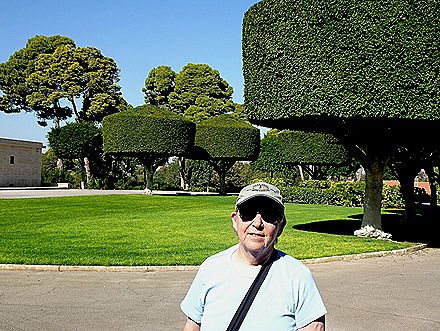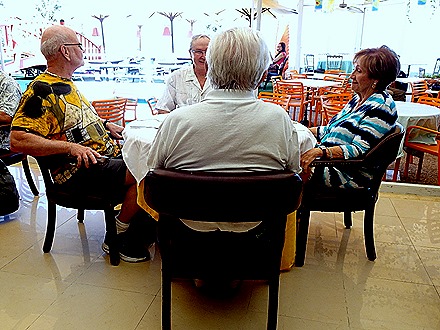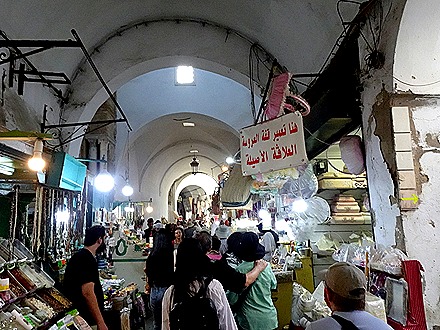Tunis, Tunisia 2022
Upon leaving Casablanca we sailed north and entered the Mediterranean Sea the next morning, October 22, sailing through the Pillars of Hercules past the Rock of Gibraltar.
By the morning of October 24 we were docked in La Goulette, the port for the city of Tunis. It lies across a large but shallow salt lake from the city. Dating back some 2,500 years or more, Tunis was originally a Berber settlement that was taken over by Phoenicians from Tyre in modern Lebanon after they founded Carthage nearby. Today it is one of the largest cities in northern Africa with a metropolitan population of about 2.7 million. This was our first visit here.
As mentioned, ancient Carthage was located near Tunis on Byrsa Hill and this was our first destination. As we walked to our excursion bus there were camels and musicians in the port area.
Founded in the 9th or 8th Century BCE, Carthage grew to become a great power in the Mediterranean world. After three major wars with Rome (the Punic wars), Carthage was completely destroyed in 146 BCE by the Roman general Scipio Africanus. About a century later Julius Caesar established a colony on the site which later grew to become the largest Roman city in Africa. The Romans levelled off the hill, pushing what was left of Carthage to the sides and burying it. So little is left to see of Carthage itself, because of its destruction & burial and because the Romans and others later built on top of its remains. Byrsa Hill provides a panoramic view of Tunis laid out below.
We stood on a large open area in front of the Carthage Museum (which we didn’t get to visit). At one end was a large ancient column in good shape. There were a few statutory remains in that area. Below the column on a lower level were the excavated ruins of the “Hannibal” section of the city, one of the few remnants of ancient Carthage that have been uncovered. This was a residential neighborhood built in the 2d Century BCE on a site previously housing metal workshops. In the distance below is the site of ancient Carthage’s ports (they had two, one commercial and the other military).
Dominating the view of Byrsa Hill behind us was the Cathedral of Saint Louis. Built by the French in the 1880’s while they controlled Tunisia, it sits on top of the ruins of a Punic temple. It was dedicated to King Louis IX of France, canonized as St Louis, who died near here trying to conquer the area during the 8th Crusade in 1270. It has not been an actual cathedral for several decades but still dominates the skyline. Across the parking area from the cathedral was a row of vendors, one invoking the name of St Louis.
We next visited the Roman amphitheater, which supposedly was the site of some Christian martyrdoms. It looked pretty much like all the other amphitheaters we have seen. It has been restored (notice the smooth seats nearby and the stone ones further away) and is used for performances.
Our next stop was the Tophet, a cemetery for children. The Romans promoted the view that the Carthaginians regularly practiced the sacrifice of children. This Roman propaganda about their greatest enemies is neither supported nor refuted by Carthaginian records because they were virtually all destroyed by the Romans in 146 BCE at the end of the Punic wars. It seems likely that there was child sacrifice here, but probably only in times of extreme crisis. Many children are buried in the Tophet but there is no definitive evidence of which we are aware as to which were sacrificed and which died naturally. The grave stones generally lack inscriptions but contain simple carved images, probably to represent who was buried there. Below the graveyard we walked through a Roman cistern.
We were told that the Emperor Hadrian (we think) visited Carthage and was appalled by the lack of water, necessary among other things for a public bath. He ordered the building of an aqueduct to supply water, which took some 20 years to complete. We passed by the remains of the aqueduct as well as some huge pipes that were used to distribute the water. The public baths were built and their remains can still be seen, although we didn’t visit them.
Although it wasn’t on the excursion agenda, we were taken next to the WWII American North Africa cemetery. In addition to lots of graves of Americans who died here during World War II laid out in neat rows, they had large mosaic maps of the North Africa campaigns. In Egypt we have seen cell phone towers disguised as very tall palm trees. Here we passed some cell towers disguised as some sort of evergreen trees, looking something like ornaments in the branches of an artificial Christmas tree.
Sidi Bou Said is a town perched on a hilltop overlooking the Mediterranean. The name is derived from a holy man who lived here centuries ago but it wasn’t until the early 20th century that it became a fashionable retreat for the rich and famous. Many well known artists and authors have lived or visited here. Since the 1920’s the buildings here have been painted blue and white. It would be a very charming place but for the hordes of tourists and vendors crowding the streets of the town and the challenging steep uphill walk to reach the Mediterranean views, but it is well worth a visit regardless. The vendors here are known for their ceramics, some very fine and some just souvenirs.
After Sidi Bou Said we went to a local restaurant for lunch. Happily the restaurant served Tunisian food (and lots of it). Our Zaandam table mates Robert, Bill, Karen & Mel were at a table behind us and beyond them was a patio with a nice Mediterranean view.
After lunch we drove into Tunis, passing what looked likeit might once have been gates to the city.
Begun in 698, about the time the Muslims took control of Tunis, the Medina covers some 700 acres and houses a population of more than 100,000 people. We left the bus in Kasbah (or Government) Square and walked past a famous old Madrassa (school) and the National Monument of Independence toward the Medina. A large mosque was on our left and some government buildings were on our right. We think the mosque is the Kasbah Mosque, built in the 13th century. After entering the Medina we walked past the Youssef Dey Mosque. Built in the 17th Century, it was the 11th mosque in Tunis and its large eight sided minaret was the first built here in the Turkish style. Next to the Mosque is the mausoleum of Youssef Dey and his family.
The streets of the Medina are mostly narrow, crooked and crowded with visitors, vendors and cafes. Some are open and some are covered. It is a fun place to explore. At one point we spotted what we think is the minaret of the Al-Zaytuna Mosque looming above the rooftops. This is the oldest mosque in Tunis, built mostly in the 7th – 9th centuries. Its current minaret was built in 1894, replacing a much shorter one constructed several centuries earlier.
As we came to the exit from the Medina we stopped for a while to permit the rest of the group to catch up before leaving. On our right was a colonnaded wall that we think is the eastern wall of the Al-Zaytouna Mosque. We have read that rooftop patios are important social venues here and we saw one above where we were waiting. And of course there were vendors, including one with a stack of stuffed camels.
So we left the Medina, climbed on the bus and headed back to the port after a very interesting day. Driving past the salt lake toward the port we saw pink flamingoes (standing on the very shallow lake bottom), but they were too far away for a picture. There was no dramatic sunset today, so I will leave you with one we saw out in the Atlantic.













































































Again, beautiful pictures and a lot of history learned from your comments. John Oakes
January 25, 2023 at 2:06 pm
I had forgotten how beautiful the rock is and how it feels to sail past her. Thanks for bringing back memories of that area. It has been almost 50 years since I was there. As always, thanks for the journal. Katie I have given up trying to post my comments. It always tells me I’m not signed in and won’t let me in. But you have seen comments before when it tells me this. Anyway, I accuses 😊I’ll just comment to your emails. Thanks. Me
😎 Karen. Sent from AOL Mobile Mail Get the new AOL app: mail.mobile.aol.com
January 25, 2023 at 11:45 pm
What great pictures. That cemetery looks very interesting. In fact so did walking through the town Village
January 26, 2023 at 12:38 am